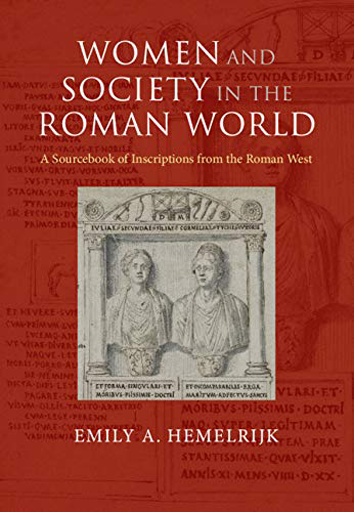
Hemelrijk's Women and Society in the Roman World is far more than just a sourcebook and serves as a helpful guide for both beginners to the Roman world and inscriptions, as well as for those more familiar with the period. The book opens with a helpful glossary, maps of Italy and the Roman Empire and abbreviations. The author acknowledges that one of the biggest challenges for interpreting these sources is that they are often found outside their original context, having been reused as pavement stones or building blocks and contain difficult abbreviations; but by studying them one gets to experience a far wider range of ancient society. The introduction discusses the different places inscriptions may be found and, along with the usual, expected inscriptions, dedications to gods and goddesses, graffiti (both the writers or commissioners and recipients are discussed) and curse tablets. Water pipes and tiles recording the names of female managers and land owners are included.
Each chapter covers a different aspect of women's lives and is far from just a list of different inscriptions but includes a detailed description of an aspect and some analysis of each inscription. One can easily dip in and out of the book, looking for specific references or read it through, gaining a wider understanding of the lives of women, particularly the parts that are often glossed over, such as their financial and business interests.
The first chapter covers ‘Family Life’ and starts with a good, clear introduction, discussing the role of women as wives and highlighting the ideals a wife would be expected to portray. There are descriptions of where each inscription was found and pictures of some of the tablets. Common terms, such as pia,’ dutiful’, are provided in Latin and English, and the inscriptions provided back up these ideals. Parts of this chapter would be particularly useful to pupils studying the Cambridge Latin Course and looking at the character of Metella, or similar courses, and would be equally useful for some of the A level Classical Civilisation topics. This book would be of great use to Classics departments looking to develop their coverage of women and girls in the Ancient World. Whilst much of this chapter was quite familiar in terms of the usual ways women are portrayed, there were some particularly interesting depictions of true marital love, including a woman whose husband offered her the services of another man to have children with and then offered to bring them up as his own. Useful explanations are provided alongside the sources and the topic is dealt with thoroughly including birth, labour, women as mothers, daughters and sisters. The loss of a child, foster- and step- families are also discussed and women are frequently praised for qualities considered ‘women appropriate’.
In the second chapter, the legal status of women is discussed, including citizenship and ethnicity. On the tombstones of slaves, little more is provided other than their age, name and occupation and we see some more detail on the tombstones of vernae or homegrown slaves, often an illegitimate child of the master. Information on tending to slaves and their costs is included, and some examples of masters marrying their slaves. Freedwomen receive more coverage of their lives on their tombstones, and there are even some examples of women marrying their ex-slaves. Naevoleia Tyche's tomb, which features in the Cambridge Latin Course Book 1, is also included, and there are many examples here which would benefit a study on slaves. A particularly erotic tombstone depicts a woman who had two male lovers at the same time and the men themselves developed such a close friendship they became like Orestes and Pylades. The legal status of slaves is discussed and examples of slaves defending their freedom in court are included and analysed along with examples of the Ius Liberorum which stated that women without a pater familias could legally become property owners once they had given birth three or four times.
The later chapters provide a rarer depiction of women in Rome than is usual and cover their role in public life, religion, occupations and their social life. Personally, I think these were the most interesting chapters and covered aspects of women rarely dealt with in such detail. In the chapter on occupations, women were seen in the usual craft industries but there were also a range of doctors, midwives, vets and dry nurses included. Freedwomen were seen buried in the family's tomb and poets, secretaries and librarians were also seen along with ex-slaves who then set up their own businesses, continuing the skill they had carried out as a slave. More disreputable professions are covered and there is an entire section on prostitutes and prices so some supervision would be required if allowing pupils to use the book!
Social relations are included and use is made of the Vindolanda tablets, defixiones and graffiti in Pompeii to look at friendships and lovers. Patronage between women is discussed and collegia appear to have been set up to help fellow women. Sources discuss their seating in the theatre, participation in games and female gladiators.
In the final two chapters, women in public life and imperial women are discussed. There are numerous examples of women as benefactors and patronesses of towns, and women are seen to bestow gifts and set up child support schemes. Deification of members of the imperial family is covered and the giving of cults and statues.
This book is full of interesting examples and analysis and provides such a broad coverage of women and their lives, with the information provided in subheadings and the introductions, means there is so much to learn here. It is expensive but so much of it can be used to augment pupils’ learning of the Ancient World, both at lower levels and for Extended Project Qualifications or extracurricular activities at a sixth form lesson. An interesting and useful addition to any Classics department.


